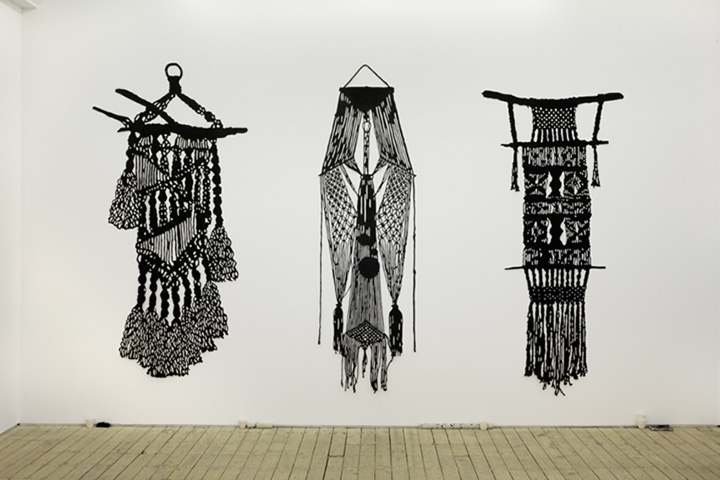WHETHER ONE THINKS OF AMANDA ROSS-HO AS A SCULPTOR, A photographer, or more broadly, a conceptual artist, it is clear that she applies a deliberate approach to exploring and controlling a passion for “stuff.” Through inventive modes of display—of objects and images that are both found and to varying degrees of her direct making—she contemplates her own aesthetic.
In “Teeny Tiny Woman” Ross-Ho draws upon a familiar set of motifs from recent work, most notably paint-streaked drywall “canvases.” These framed-up sheetrock planks lean against gallery walls to signify the germination space of the artist’s studio. She pins or tapes images and small objects to them, and installs sculptural pieces amidst them. It’s a set-up that functions like animation storyboards and architectural models, as analytical tools to diagram acts of creative thought and production.
“Teeny Tiny Woman” conjures up the artist’s younger self, growing up in a family of photographers and painters, presumably with encouragement and freedom to try her own hand at making art. She’s the daughter who metaphorically inherited two ginormous artists’ smock-shirts and use of a four-times-life-sized enlarger. The latter is clearly the centerpiece of the exhibition: Omega (2012) is a fake, but it looks shockingly real, with a wooden baseboard and all-metal parts found or fabricated to scale.
Nostalgia can be dangerous territory. But Ross-Ho’s sweet homage to her creative family is fortunately cloaked in an industrial, work-obsessed vibe. Glass bottles with dark liquid line the museum stairs; a re-photographed portrait of the artist at age 11 with a wooden toy camera crafted by her father; a darkroom timer; a reproduction of her mother’s photograph of a window; partially painted canvases and folded drop-cloths; strips of artists’ blue tape; colorful paintings that replicate ones the artist made as a child. Then there is work by the grown-up Amanda Ross-Ho, whose still-childlike playfulness can be felt in acts like stringing cheap jewelry across a museum cart.
Curators see exciting possibility in Ross-Ho’s signature amalgam of painting, photography and sculpture, and in just a few short years she has gained national-level status. Two years ago she was included in MoMA’s annual “New Photography” exhibition, where her Richard Prince-like strategy of re-photography and her Wolfgang Tilmans’ display-style aesthetic became a lightning rod to criticize the curator’s decision to include her (likely because the field of art photography itself is still quite insular). But as much as the artist herself seems to assert that she is a photographer, her art is most interesting as a hybrid with sculpture.
The affective qualities of Ross-Ho’s art are most potent within the relative intimacy of smaller settings than the museum’s large, single-gallery, second floor. “Teeny Tiny Woman” suggests Ross-Ho’s experimentation with size and scale could actually stand to become more pronounced. This playful mode of deception offers an appropriate spatial and visual negotiation to enhance the intriguing slippages between her funky images, objects, and their contexts.
– Anne Martens


